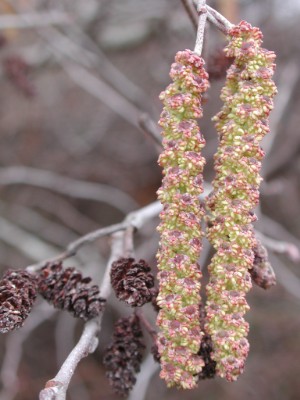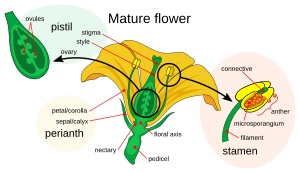Flowering plant sexuality facts for kids
Have you ever wondered how plants make new seeds? Just like animals, plants have ways to reproduce. This article explains the different ways flowering plants show their "gender" or how their flowers are set up to make new plants. It's all about the male and female parts of a flower!
Understanding Flower Parts
Let's look at the different types of flowers you might find:
- Bisexual or perfect flowers: These flowers are like a plant's "all-in-one" package. They have both male parts (called stamens, which make pollen) and female parts (called the gynoecium, which holds the seeds). Most big, showy flowers like lilies and roses are perfect flowers. A complete flower is a perfect flower that also has petals and sepals (the leaf-like parts under the petals).
- Unisexual flowers: These flowers are either male or female, but not both. They are also called imperfect flowers. A male flower only has stamens, and a female flower only has the gynoecium.
How Plants Show Their Gender

Some plants have flowers with both male and female parts. Other plants might have only male or only female flowers. And some plants even have a mix of male and female flowers on the same plant!
Sometimes, a plant can even change its "gender" over its lifetime. For example, a plant called Jack-in-the-pulpit might start by producing only male flowers when it's young and small. As it grows bigger over the years, it might start producing more female flowers, or even a mix of both!
Here are some special terms to describe how plants arrange their flowers:
- Hermaphrodite: This is a plant that only has bisexual (perfect) flowers. Remember, these flowers have both male and female parts.
- Monoecious: Imagine a plant that has both male flowers and female flowers, but they are separate flowers on the *same* plant. That's a monoecious plant! The word "monoecious" comes from Greek, meaning "one household." For example, a corn plant has male flowers (the tassel at the top) and female flowers (the ears of corn) on the same plant. Some monoecious plants might even produce male flowers first, and then switch to female flowers later in the season.
- Dioecious: This is when a plant species has separate male and female plants. So, one plant will only have male flowers (and make pollen), and another plant of the same species will only have female flowers (and make seeds). "Dioecious" means "two households" in Greek.
- Androecious: These are the male plants in a dioecious group. They only produce male flowers and pollen.
- Gynoecious: These are the female plants in a dioecious group. They only produce female flowers and seeds.

- Polygamy: This is when a single plant has a mix of male flowers, female flowers, and perfect (bisexual) flowers all at the same time!
- Trimonoecious: This is a specific type of polygamy where male, female, and hermaphrodite (perfect) flowers are all found on the same plant.
Related pages


